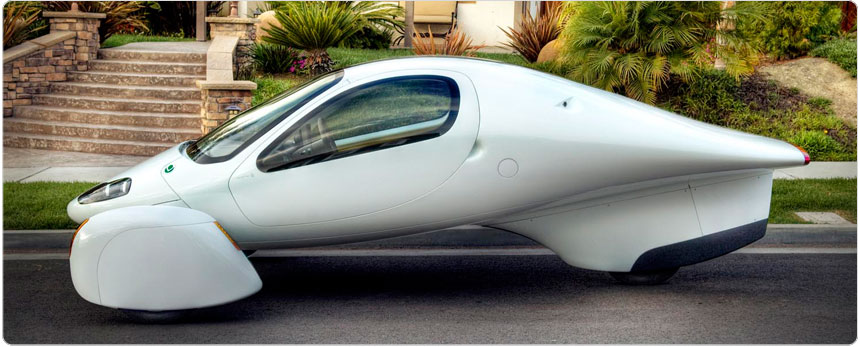 Wow. I know that other people might be well aware of this vehicle … but I just found it and this is impressive. Aptera Motors, Inc. – based out of Carlsbad, California – is creating a revolutionary commuter vehicle and is about to go into production. For the last five years they have been designing and testing this new Typ-1 passenger vehicle that is like nothing I every imagined being this close.
Wow. I know that other people might be well aware of this vehicle … but I just found it and this is impressive. Aptera Motors, Inc. – based out of Carlsbad, California – is creating a revolutionary commuter vehicle and is about to go into production. For the last five years they have been designing and testing this new Typ-1 passenger vehicle that is like nothing I every imagined being this close.
The Aptera Typ-1 details are amazing …
The Typ-1 uses a commoditized, ‘ruggedized’ 3-phase motor controller designed for vehicular applications, and a 3-phase motor made for us by a company here in Southern California. The rear drive suspension, and the drive reduction, are all designed and made by Aptera. Since the Typ-1e (electric) and the Typ-1h (series plug in hybrid) have different battery needs, this may result in different battery manufacturers for the two models. The Typ-1e is designed to use a 10 KWh pack, while the Typ-1h uses a smaller pack. The cycles and DOD are different for both applications. We will announce further information regarding the battery lifespan and warranty policy well before we begin manufacturing the Typ-1 next October.
Diesel or Gasoline? Our first prototype, the Mk-0, was a parallel hybrid Diesel and achieved an average of 230 MPG at a steady state of 55 MPH. This was pure Diesel/mechanical drive with no electric assist. Diesel is attractive for its Carnot efficiency and the increased enthalpy of Diesel fuel vs gasoline. However, diesel contains lots of unburned hydrocarbons and NOX compounds, and it’s impossible to get a small Diesel engine certified for emissions in California. Therefore, the typ-h uses a small, water-cooled EFI Gasoline engine with closed loop oxygen feedback and catalytic converter. This engine is coupled to a lightweight 12KW starter/generator. It’s very clean and quiet.
The design is three-wheeled, allowing it to be classified as a motorcycle in many states … and allowing it to use the commuter lanes. As for the performance?
With the All Electric Aptera, it is very easy to figure out the mileage range. The mileage is determined by the distance you can drive, under normal circumstances, until the batteries are effectively drained. In the case of the first Aptera typ-1e, we have calculated the range to be about 120miles.
With the Plug-in Electric Hybrid version of the Aptera(typ-1h) the mileage of the vehicle is difficult to describe with one number. For example, the Typ-1h can drive 40 to 60 miles on electric power alone. Perhaps for such a trip, the engine may only be duty-cycled for a few seconds or minutes. This would produce a fantastic number, an incredible number that, though factually true, would have no useful context, i.e. it’s just a point on a graph.
An asymptotic decaying exponential is an accurate way to describe the fuel mileage of the Typ-1h. For example driving say, 50 miles, one might calculate a MPG number that’s 2 or 3 times higher, say, 1000 MPG. As battery energy is depleted, the frequency of the engine duty cycle is increased. More fuel is used. at 75 miles, the MPG might be closer to 400 MPG. Again, we’re using battery energy mostly, but turning the engine on more and more. Just over 100 miles we’re just over 300 MPG, and just beyond 120 miles, we’re around 300 MPG.
So why pick a number at 120 miles? Well, it’s more than double of most available plug-in hybrid ranges that achieve over 100 MPG. It’s three times the distance of the typical American daily commute. It’s a meaningful distance that represents the driving needs of 99% of Americans on a daily basis. Sure, it’s asymptotic, after 350-400 miles it eventually plummets to around 130 MPG at highway speeds where it will stay all day until you plug it back in and charge it up.
And all of this for an estimated $30,000 sticker price! Read more of the Aptera facts and then think about driving one of these to work … I want one! The problem is that for now they are limiting the market to the LA area … bummer.
